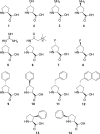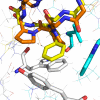Rational design of alpha-conotoxin analogues targeting alpha7 nicotinic acetylcholine receptors: improved antagonistic activity by incorporation of proline derivatives
- PMID: 19131337
- PMCID: PMC2666602
- DOI: 10.1074/jbc.M806136200
Rational design of alpha-conotoxin analogues targeting alpha7 nicotinic acetylcholine receptors: improved antagonistic activity by incorporation of proline derivatives
Abstract
Nicotinic acetylcholine receptors (nAChRs) are ligand-gated ion channels that belong to the superfamily of Cys loop receptors. Valuable insight into the orthosteric ligand binding to nAChRs in recent years has been obtained from the crystal structures of acetylcholine-binding proteins (AChBPs) that share significant sequence homology with the amino-terminal domains of the nAChRs. alpha-Conotoxins, which are isolated from the venom of carnivorous marine snails, selectively inhibit the signaling of neuronal nAChR subtypes. Co-crystal structures of alpha-conotoxins in complex with AChBP show that the side chain of a highly conserved proline residue in these toxins is oriented toward the hydrophobic binding pocket in the AChBP but does not have direct interactions with this pocket. In this study, we have designed and synthesized analogues of alpha-conotoxins ImI and PnIA[A10L], by introducing a range of substituents on the Pro(6) residue in these toxins to probe the importance of this residue for their binding to the nAChRs. Pharmacological characterization of the toxin analogues at the alpha(7) nAChR shows that although polar and charged groups on Pro(6) result in analogues with significantly reduced antagonistic activities, analogues with aromatic and hydrophobic substituents in the Pro(6) position exhibit moderate activity at the receptor. Interestingly, introduction of a 5-(R)-phenyl substituent at Pro(6) in alpha-conotoxin ImI gives rise to a conotoxin analogue with a significantly higher binding affinity and antagonistic activity at the alpha(7) nAChR than those exhibited by the native conotoxin.
Figures







References
-
- Sine, S. M., and Engel, A. G. (2006) Nature 440 455-463 - PubMed
-
- Jensen, A., Frølund, B., Liljefors, T., and Krogsgaard-Larsen, P. (2005) J. Med. Chem. 48 4705-4744 - PubMed
-
- Sher, E., Chen, Y., Sharples, T. J., Broad, L. M., Benedetti, G., Zwart, R., McPhie, G. I., Pearson, K. H., Baldwinson, T., and DeFillipi, G. (2004) Curr. Top. Med. Chem. 4 283-297 - PubMed
-
- Lukas, R. J., Changeux, J.-P., Le Novere, N., Albuquerque, E. X., Balfour, D. J. K., Berg, D. K., Bertrand, D., Chiappinelli, V. A., Clarke, P. B. S., Collins, A. C., Dani, J. A., Grady, S. R., Kellar, K. J., Lindstrom, J. M., Marks, M. J., Quik, M., Taylor, P. W., and Wonnacott, S. (1999) Pharmacol. Rev. 51 397-401 - PubMed
-
- Armishaw, C. J., and Alewood, P. F. (2005) Curr. Protein Pept. Sci. 6 221-240 - PubMed
Publication types
MeSH terms
Substances
LinkOut - more resources
Full Text Sources
Other Literature Sources

